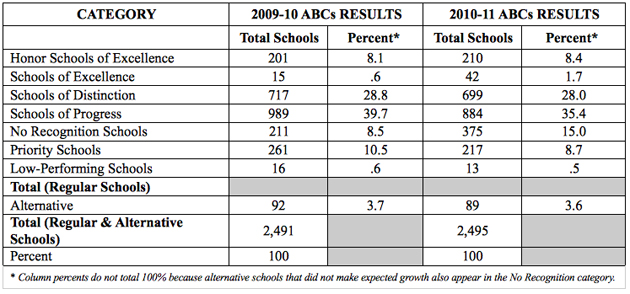For Immediate Release
Graduation Rates Increase in 2010-11; Fewer Schools Meet Growth Goals
High school graduation rates improved in 2011, increasing to 77.7 percent, the highest four-year graduation rate ever reported in North Carolina. At the same time, other performance measures were similar to last year, according to the student and school achievement results reported today to the State Board of Education.
The 2010-11 ABCs of Public Education accountability report indicated that the percentage of students graduating in 2011 in four years or less increased by 3.5 percentage points from 2010. In addition, the percentage of students graduating in five years increased to 77.7, a 3.0 percentage-point increase from 2010.
The report also showed 81.4 percent of schools meeting or exceeding their academic-growth standard, a decline from 2009-10 when 88.0 percent met or exceeded their growth standard.
“Congratulations go to our schools and students for their continued focus on high school graduation as an important accomplishment for all,” said State Superintendent June Atkinson. “I am concerned, however, that we are beginning to see the consequences of continued education cuts over the past three years. When state resources for teachers and students shrink every year, it makes it more and more challenging to support students’ academic growth.”
Bill Harrison, chairman of the State Board of Education, also was pleased to see that the graduation rate was up again in 2011. “As evidenced by the continued improvement in the state’s graduation rate, our schools are making significant strides during very difficult budget times,” Harrison said. “It is imperative that we do everything we can to support our students so that when they graduate they are career and college ready and on track for a successful future.”
The percent and number of schools in each tier of school performance and recognition are displayed below along with the prior year’s numbers.

The ABCs report also includes information about Adequate Yearly Progress (AYP), the federal measure of school progress. AYP is required under the federal Elementary and Secondary Education Act, also known as No Child Left Behind. The AYP measure requires schools to meet specific performance targets for each subgroup of students. These targets include proficiency on state tests and also graduation rates (for high schools) and attendance rates (for elementary and middle schools). This year, the percentage of schools making AYP decreased, in part because the proficiency targets for AYP increased for the 2010-11 school year (see below chart). The law requires states to incrementally move their AYP proficiency targets until they reach 100 percent in the 2013-14 school year.

In order to make AYP, schools must meet the annual targets for each subgroup of students. If even one group misses the target, the school is considered to have not made AYP. In fact, across North Carolina many schools met a significant percentage of their targets. In North Carolina, 27.7 percent of schools made AYP, down from 58.0 percent in 2010. Overall, North Carolina schools had a total of 43,323 AYP targets and 81.2 percent of these were met. More information about the federal requirements, AYP targets and other details are online at www.ncpublicschools.org/nclb.
The ABCs report is based on several measures of performance. These include reading and mathematics end-of-grade tests in grades three through eight; science end-of-grade tests in grades five and eight; and end-of-course tests in Algebra I, Algebra II, Biology, English I, U.S. History, Civics and Economics, and Physical Science along with the Writing Assessment at grade 10. Other measures include the dropout rate, completion of certain courses of study and student performance on alternate assessments for certain students with disabilities.
This is the 15th year of North Carolina's ABCs program. For the third consecutive year, the state's budget has not included funding for ABCs incentive awards for qualifying educators. These awards were an integral part of the program until 2009.
A total of 2,495 public schools and public charter schools were assigned a status in the ABCs of Public Education. Complete results for all of these schools may be viewed at
http://abcs.ncpublicschools.org/abcs. A background packet providing an overview (including definitions of the various recognition categories) of the ABCs accountability program and changes to the program in 2010-11 also is available on this site. For district and high school graduation rates, please visit
www.ncpublicschools.org/graduate/statistics/.


